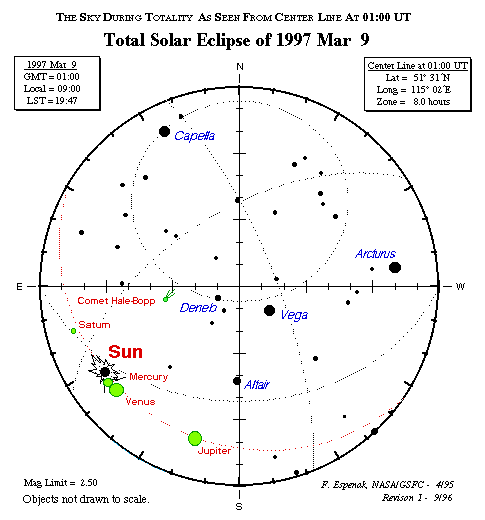
|
|---|

|
|---|


Excitment is growing around the discovery of a new comet on 1995 July 23. If Comet Hale-Bopp lives up to current expectations, it will be visible to the naked eye during the total solar eclipse of 1997 March 9. The path of this eclipse runs through Mongolia and eastern Siberia and has a center line duration of more than two minutes. The Sun will be low in the sky along the entire track, never climbing higher than 23o. Complete details for the eclipse are available in NASA RP1369: Total Solar Eclipse of 1997 March 9.
According to IAU Circular No. 6202, the predicted magnitude of Comet Hale-Bopp will be -0.9 on 1997 March 3 and -1.4 on 1997 March 13. These magnitude estimates are based on the comet's current brightness, a pre-discovery photograph from 1993 April, and the assumption that the comet is not exhibiting any uncharacteristic outbursts. More recent magnitude estimates (1996 Aug 19) from Dr. Don Yeomans (JPL) predict magnitudes of -0.4 on 1997 March 6 and -0.7 on 1997 March 11. If these estimates hold true, Hale-Bopp will shine at magnitude -0.5 to -1.0 during the total eclipse, making it an easy naked eye object.
It should be strongly emphasized that the above magnitude predictions for Comet Hale-Bopp are only educated 'guesstimates' based on the comet's current brightness and behavior. Due to the unpredictable nature of comet activity, it is impossible to accurately predict the brightness of a comet months or even weeks in advance. In spite of this cautionary note, Comet Hale-Bopp currently holds great promise in becoming the brightest comet seen in several decades, eclipse not withstanding.
During the eclipse, Hale Bopp will be north of Pegasus in Lacerta, about 47o from the Sun. For an observer on the center line north of Ulaanbaatar, the eclipsed Sun and Comet Hale-Bopp will have the following coordinates:
Sun: Altitude = 13o Comet Hale-Bopp: Altitude = 55o
Azimuth = 113o Azimuth = 89o
This places the Comet about 24o to the left and 42o above the Sun from northern Mongolia.
Photographers hoping to catch the eclipsed Sun in the same frame with the Comet should note the fields of view of various 35mm camera lenses:
Focal
Length Field of View
(mm)
20 68.8o x 103.1o
24 57.3o x 85.9o
28 49.1o x 73.7o
35 39.3o x 58.9o
50 27.5o x 41.3o
A 35 mm lens will allow you to comfortably place the Sun in the lower right corner and capture the Comet in the upper left corner.
A 28 mm lens will let you photograph the horizon and more of the foreground in addition to the eclipsed Sun and Comet.
The following diagram shows the sky during totality as seen from the center line in eastern Russia at 01:00 UT. The appearance of the sky will be quite similar from Mongolia. Mercury (m=Ð0.2), Venus (m=Ð3.5) and Jupiter (m=Ð1.5) should all be easily visible during the total eclipse. Saturn (+1.3) is another possiblity if sky transparency is good. Among the bright stars which may be visible are Vega (m=+0.03), Deneb (m=+1.25), Altair (m=+0.77), Capella (m=+0.08), and Arcturus (m=-0.04).

|
|---|
The visibility of a comet during a total solar eclipse is quite a rare event and has only happened several times in the last century or so. During the eclipse of 1882 May 17, a naked eye comet was observed from the path of totality in Egypt.
Jean Meeus reports that a comet seen during the total solar eclipse of 1947 May 20 from Brazil was observed by Van Biesbroeck. Since Comet Rondanina-Bester (1947 IV = 1947 b) was only of magnitude 4 or 5, the observation should be considered a "limiting case". Surely Van Biesbroeck knew in advance where the comet was, and actively searched for it. It certainly wasn't an impressive naked eye object like the 'Eclipse Comet of 1948'.
Guy Ottwell notes that a bright comet (1948 XI) was seen during the solar eclipse of 1948 November 1 from southern Kenya. It became known as the 'Eclipse Comet of 1948' when it emerged from the Sun's glare a week after the eclipse as a fine naked eye object. It sported a thirty degree tail but was only visible from the southern hemisphere. Indeed, some eye-witness accounts of the comet's appearance were reported in the pages of Sky & Telescope (January 1949, p. 59-60).
Thus, the 1997 eclipse holds the promise of an especially unique and rare opportunity. Are there any other references to eclipse comets still buried in the literature?


WebMaster: Fred Espenak Planetary Systems Branch - Code 693 e-mail: espenak@lepvax.gsfc.nasa.gov NASA/Goddard Space Flight Center, Greenbelt, Maryland 20771 USA
|
|---|
